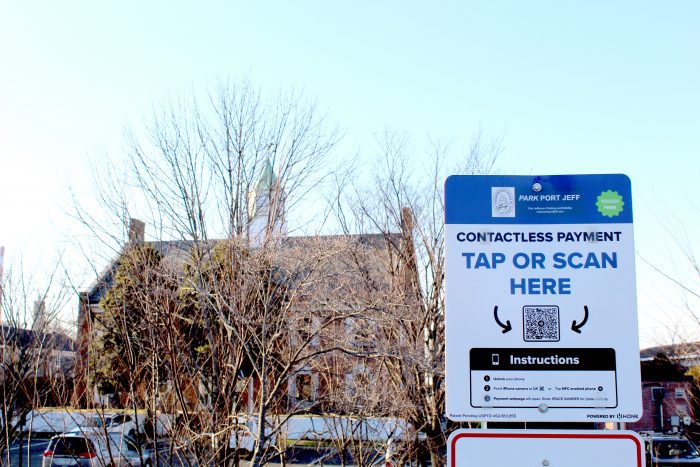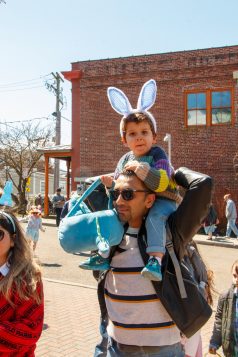
As Port Jeff braces for heightened flooding, work begins to manage ‘water problem’

Between rising sea levels, more frequent and intense storms and a changing climate, the Village of Port Jefferson is also addressing longstanding flooding concerns.
Public officials, architects and residents gathered at Village Hall on Wednesday, April 5, sharing updated findings of the ongoing village Climate Resilience Plan in a community workshop. With water targeting the village from all angles, data is being used to develop new intervention strategies.
“The Village of Port Jefferson, Drowned Meadow if you will [the village’s original name], has had unending issues with flooding as a result of topography, tides, runoff, rains, storms, a shallow water table and many other issues,” said Deputy Mayor Kathianne Snaden. “I believe tonight’s workshop will be extremely helpful in moving Port Jefferson toward the ability to implement a responsible and solid resiliency plan.”
Trustee Rebecca Kassay, the village’s sustainability commissioner, updated the public on the status of the Project Advisory Committee. Composed of residents, contractors, Conservation Advisory Council members and Amani Hosein, legislative aide to Town of Brookhaven Councilmember Jonathan Kornreich (D-Stony Brook), the PAC is pursuing the Climate Resilience Plan for the village with a focus on flooding.
The study is made possible by an $82,500 grant from the New York State Department of State to fund the creation of the Port Jeff plan. Michael Schwarting is a partner of the local Campani and Schwarting Architects, one of the firms hired to carry out various tasks associated with the grant. During the meeting, he updated the public on the study’s findings.
Flooding: an Achilles’ heel
Schwarting analyzed Port Jeff’s long history of flooding using historical aerial photographs and maps. He identified various hidden water bodies, such as Crystal Lake near the fire station and other creeks and streams, flowing beneath the existing built environment in Lower Port.
“The maps tell us a good deal about the conditions, and what we know is that it’s all still there,” he said. “That water is underground, and it doesn’t go away.”
Schwarting said three factors work to exacerbate flooding conditions: rising tides, waters below the surface and low-lying topography. “Those three things interact with one another to cause the problems that we’ve been having in the past, are still having and will have in a worse way, according to predictions,” the architect said.
The village is simultaneously afflicted by water from above, with projections for more frequent and intense precipitation events due to climate change. “The prediction is that the storms are going to increase,” Schwarting said, adding that as global sea levels rise, Port Jeff Harbor is projected to begin spilling over into much of the downtown business district.
Potential solutions
Despite the challenges ahead, Schwarting maintained that there are some natural remedies to help counteract these threats.
Storm drainage systems and rain gardens, for example, are already in place, collecting and channeling some of the stormwater load into the ground. Bioswales, bioretention planters and permeable pavement systems offer other modes of stormwater discharge and filtration, assigning it a reuse function as well.
The architect also proposed transitioning hardscape surfaces along the harbor, such as the Town of Brookhaven parking lot, as green space, which could add scenic value while acting as a floodwater sponge.
The next stages of the study will involve collecting more resident feedback and defining projects worth public consideration. Schwarting said a similar meeting would take place as those phases progress.
“We will start to move toward solving the problem now that we have spent quite a bit of time understanding the problem,” Schwarting said.
Kassay acknowledged the complexities of the flooding question, referring to these initial findings as “a little overwhelming.” Despite this, she maintained that planning and intervention remain the proper path forward.
“The only thing worse than digging into this problem is to ignore it because it’s happening, whether or not we do something,” she said. “We really need to come together to prioritize, make these decisions and support this work so that it is guided toward the result that you wish to see as a community.”

To view the full presentation and the Q&A portion of the meeting, see video above. To respond to the Port Jefferson Village Climate Resilience Survey, scan the QR code.
Hundreds converge upon Port Jeff’s Harborfront Park during Easter Parade
The Port Jefferson community marked yet another successful Easter Parade this year, with hundreds turning out for the festivities.
Hosted by the Greater Port Jefferson Chamber of Commerce, the parade route started at Theatre Three, working down Main and finishing at Harborfront Park. Once there, a wild frenzy ensued, with children and parents rushing to the park to collect the hidden eggs.
Fun and merriment went all around, the community and chamber capping off another memorable annual Easter tradition.
— Photos by Greg Catalano
‘A giant step backward’: Port Jeff village board rescinds term extensions, passes budget

The Village of Port Jefferson Board of Trustees unanimously approved the annual budget Monday evening, April 3, though appropriations weren’t top of mind for the sea of residents crowding the boardroom.
Dozens turned out to confront the board over its recent decision to extend the terms of service for village offices from two to four years — a decision it promptly reversed. Less than 90 days until village elections, the community and board instead now grapple with the competing demands of streamlining election administration and public oversight over term changes.
“We wanted to kind of say ‘sorry’ and take a giant step backward,” Mayor Margot Garant told the public.
Upon rescinding the resolution, the mayor noted the need to relieve village clerk Barbara Sakovich in administering the coming June elections, adding that neighboring municipalities have generally implemented such changes.
“Probably the majority of other townships and municipalities — villages specifically — have their elections in March and have moved to four-year terms,” she said. “I think it’s the direction we may all agree to at some point,” but the board is “taking pause” before rendering further judgment.
Trustee Rebecca Kassay offered to begin exploring how other municipalities procedurally implemented term changes, keeping open the possibility of forming a committee to collect public input on the matter.
“Please look probably to the next meeting if you want to get this going while everyone has it in mind,” she said, adding the board “will be talking more about the process of helping to gather resident input and really handing it to the residents to make these decisions.”
In the wake of the reversal, Deputy Mayor Kathianne Snaden and trustee Lauren Sheprow, both mayoral candidates, offered their commentary. Snaden said she had a change of opinion after learning of the high signature threshold to move the measure onto the June ballot via permissive referendum.
“It just made sense to me at the time, again, because of the ability for the residents to come forth and let us know,” she said. “After that happened and I heard from some residents — what the numbers were for them to bring forth the permissive referendum, that’s when I said that’s burdensome.”
The deputy mayor added, “We’ve had discussions, and we talked about bringing it tonight and considered rescinding and starting from scratch, giving it to you guys to say to us what you want to do.”
Sheprow raised the possibility of the village acquiring electronic voting machines ahead of the June elections.
“What we didn’t realize when we were meeting, and it really wasn’t discussed holistically at the last meeting, was whether or not there are voting machines available to rent or purchase,” she said. “As long as they’re certified by the Suffolk County Board of Elections, we have that option available to us.”
Leaders of the recently resurrected Port Jefferson Civic Association made formal contact with the village government, exchanging introductions and outlining their organizational agenda.
Civic president Ana Hozyainova thanked the board for rescinding the resolution for term extensions but asked for more public input over village decision-making.
“The civic association didn’t take a stance on whether it should be two or four years but really took objection to the fact that such an important issue which doesn’t have a clear-cut solution … was taken without any public debate,” she said, adding that more public deliberations over fortifying the eroding East Beach bluff could have occurred.
The board approved $0.50 increases in managed parking rates for weekdays and weekends, setting the rates at $1 per hour Monday through Thursday and $1.50 per hour Friday through Sunday.
Budget highlights
Village treasurer Denise Mordente delivered the fiscal year budget presentation, highlighting the budgetary constraints imposed by rising inflation and costs, also declining public revenues from the Long Island Power Authority through the Port Jefferson Power Station.
“The interest for our [bond anticipation notes], gasoline, heating oil, all of that ties in,” Mordente said. “We tried as best as we can to not put the burden again on the taxpayers.”
The budget increased by 7% from last year from $10.59 million to $11.37 million. However, the village drew $257,882 from its $1.8 million fund balance to minimize tax increases, Mordente explained. The village lost roughly $107,000 through the LIPA glide path agreement, with 15% and 20% increases in medical benefits and insurance, respectively.
The village committed to reductions in staff, opting against filling some vacant positions while assigning multiple titles to existing personnel. The administration also instituted a spending freeze for department heads, who stayed within their respective budgets from last year.
“The overall for our tax increase on an average house of $1,500 [assessed valuation] is $75 a year,” Mordente said. “We’re trying not to impact the way of life for our village.”
The Board of Trustees will meet again Tuesday, April 18, at 3 p.m., with scheduled presentations from Johnson Controls and the Six Acre Park Committee.
To watch the full general meeting, see video above.
Blue Alert System implemented on Long Island

A system to track down those who kill or injure law enforcement officers across the nation has been implemented locally.
The Blue Alert System was recently rolled out in New York state and on Long Island.
State Assemblyman Steve Stern (D-Dix Hills), one of the sponsors of the legislation to utilize the alert system, announced the implementation at a March 24 press conference in Mineola. The system is designed to help apprehend suspects who authorities believe killed or seriously injured a local, state or federal law enforcement officer.
The state Legislature unanimously approved the legislation.
“I was proud to sponsor and pass this critically important legislation in support of the brave men and women of law enforcement who sacrifice so much to keep our neighborhoods safe,” Stern said in a press release. “The Blue Alert System has a proven track record of success nationwide and its implementation is long overdue in New York state. This initiative will help protect our community, protect our officers and save lives.”
The Blue Alert System is similar to the Amber Alert used to find missing children and the Silver Alert for missing vulnerable adults. New York joins 37 other states in using the new system, including New Jersey, Connecticut and Vermont. According to Stern’s office, the law creating the system went into effect March 16, allowing the New York State Division of Criminal Justice Services to begin issuing alerts when needed. The state agency will be in consultation with law enforcement authorities.
The system is modeled after the nationwide alert system titled Rafael Ramos and Wenjian Liu National Blue Alert Act of 2015. The nationwide system was named as such to honor Ramos and Liu, two New York City police officers who were killed in the line of duty in Brooklyn in 2014.
Among the system’s supporters is Suffolk County District Attorney Raymond Tierney (R), who was on hand for the press conference.
“Police officers go to work every day facing the risk of physical danger or death, selflessly confronting that peril to allow us the chance to live in peace,” Tierney said in a press release. “An attack against our first responders is an attack against our society and we must take every measure possible to help ensure the safety of our police.”
Law enforcement agencies can request the alert if they believe “that the public dissemination of information may help avert further harm or accelerate apprehension of the suspect,” according to the legislation. Depending on the case, the alert can be issued on a regional or statewide basis. The system will be used in coordination with the New York State Department of Transportation, public television and radio broadcaster organizations. Information may include details such as the suspect’s vehicle or license plate number.
The National Fraternal Order of Police has reported as of April 3, 99 officers in the country have been shot in the line of duty so far this year, a 44% increase from 2021 year to date. Of the 99 shot, 10 of them were killed by gunfire, which is 33% less year to date from 2021.
One-on-one with Rebecca Kassay: Port Jeff trustee on climate-resilience planning
The Village of Port Jefferson will host community members for the Climate Resilience Plan workshop on Wednesday, April 5, at Village Hall from 6:30 to 8 p.m. During this meeting, residents will learn about the climate phenomena impacting the area, such as rising tides and intensifying flooding.
In an exclusive interview, trustee Rebecca Kassay, who also serves as the village’s sustainability commissioner, offered a preview of the meeting, detailing challenges associated with worsening flooding, accelerated erosion and the need to plan accordingly.
What are your expectations for the April 5 meeting?
The upcoming meeting is funded by the [New York State] Department of State under a grant that helps Port Jefferson Village plan to be a climate-resilience community. This information is pertinent to every community, but especially in a village like Port Jefferson, where we have such an intimate relationship with the harbor.
In our history, the village was named Drowned Meadow because it was a marshland. No one needs to be told that we’ve been experiencing increasing frequency, and the amount of flooding has increased greatly. We’re looking at this very seriously as a village on how to mitigate the flooding as climate change continues to increase in its impacts.
What is climate-resilience community planning?
A climate-resilience plan is planning to undertake both green and gray infrastructural projects as well as shifting planning and expectations in the community regarding the facts of climate change.
One of these for us is sea-level rise, the water level in the harbor being higher. Another notable one for us is the increased frequency of heavy rainfall, which causes flooding. In a climate-resilience community, we are planning to mitigate the flooding results from the effects of the climate.
Unfortunately — and I always feel like the bearer of bad news — flooding will affect almost every shoreline community on Long Island in an increasingly drastic way. As a community, we need to digest this future, start planning to protect the community assets that are most important to us and make the best planning and fiscal decisions for our future as a village.
Do you foresee coastal erosion mitigation as part of this equation for developing climate-resilience community planning?
Coastal erosion definitely falls under the umbrella of the results of climate change. We’ve been seeing this problem increase, especially in the last 10 to 20 years. Erosion is a natural process. It does happen over time. We’ve just seen a huge increase in the rate of coastal erosion.
Looking at coastal erosion and what our community plans to do regarding coastal erosion is part of climate resilience planning. Sometimes planning means building an infrastructure project, and sometimes it means a strategic retreat from an area that we, as a community, believe floods too frequently or is eroding at such a rate that the assets within that zone are very difficult and costly to protect.
One of the most difficult things about climate planning is that you have to realize that what’s been working for the last 50 to 100 years will not necessarily work in the near future.
What are some distinguishing characteristics between sustainable planning and the kind of planning that has existed up to this point?
The difference actually starts with being able to humble ourselves enough to realize that human-made solutions will not always solve the problem of climate change.
In the past 50-plus years, if there’s an issue with flooding or erosion — all these different problems that now fall into the realm of climate change — we as governments and communities have said, “Let’s build a project to fix it.” But the scale at which we are looking at climate issues is so vast that the thinking has to shift.
We have to realize that the environment is shifting around us, and our built environment is butting up against it in a way that we might have to change what we’re doing. It’s more working with nature as opposed to continually trying to work against it.
What role can residents play in this effort, and how critical is it for residents to educate themselves about the climate issues at stake?
The best way to fight fear is with action. I acknowledge completely that hearing and internalizing climate change data and projections is a very scary process.
I am currently working with [New York] Sea Grant and their local representative, Elizabeth Hornstein. We’ve recently discussed creating a workshop aimed not just at governments and nonprofits but at individual landowners, businesses and residents to empower them on what they can do with their properties to help mitigate climate change issues.
I’m hoping that within the next few months, we might be able to come up with a date for a workshop like this where residents can tune in and see if there are actions they can take to help. The Conservation Advisory Council in Port Jefferson has been working on some strategies [as a village advisory body].
We’ve designed this workshop so that it will be recorded in a high-quality fashion, just like the Board of Trustees meetings, so that residents who cannot or choose not to attend can view the meeting indefinitely on the village’s YouTube page.
Port Jeff Village to pioneer PASSPort, a municipally operated rideshare service

Village of Port Jefferson officials are currently rolling out PASSPort, a first-of-its-kind rideshare service tailored for within-the-village transit.
Kevin Wood, the parking and mobility administrator in PJV, worked closely with the village Board of Trustees to develop the software and systems to accommodate PASSPort. Now the service is undergoing beta testing, with plans for public use along the horizon.
PASSPort functions similarly to other popular platforms in the private sector, tapping into the same technologies used by services such as Uber but repurposing them for local municipal oversight and administration.
Under the current plan, Wood said the program remains flexible, subject to villagers’ evolving needs. “There is no parallel to this on Long Island,” he said.
While the village has attempted to administer similar transit services in the past, Wood held that PASSPort represents a significant departure from any past or current offerings. “The closest you came to this were crosstown electric car methods that, in Port Jefferson, have proven to not work for various reasons,” he said.
He added that through PASSPort, the village government hopes to move away from the public perception surrounding those previous models, which he said were ill suited for winter weather and unable to traverse the area’s steep hills.
Wood noted the various opportunities for residents to make use of PASSPort. According to him, the platform could potentially enhance mobility for those traveling to village beaches, elderly residents unable to operate a car and residents traveling downtown.
Although some apps, such as Uber, bar minors from accessing their service, Wood kept open the possibility in Port Jeff, saying that the village is working through legal parameters of creating a parental authorization process to enable the pickup and drop-off of local students.
The parking and mobility administrator also touched upon the subject of PASSPort vehicle operators. For him, the vehicles would ideally be operated by professional, third-party drivers who would be “exclusive to us for that night” during a designated period.
“We want them to have a certain amount of professional aspect to what they’re doing,” he said. “That’s an important part of this — to monitor not only the integrity of the service itself and timeliness but the courtesy of the driver.” Given the program’s flexibility, he said he could foresee accommodating multiple drivers a night if needed.
Pricing is also variable, with Wood hoping to learn more about this facet of the program as the program rolls out for public use. Measuring PASSPort against taxicabs and other rideshare methods, he foresees clear advantages to the village program.
“We know that if you took a taxi, that would be … one, a different experience; two, they’d have to be available; and three, that price, I understand, is between $7 and $10,” he said. “We think we’re coming out with a more efficient service, much better technology and we’re still pricing it at the $5 to $8 per person level.”
While PASSPort unleashes private sector technologies for municipal administration, Wood suggested the program is not necessarily intended to outcompete rival services. Instead, he viewed the platform as a village service.
“We’re not in the business of competing with mobility — we’re in the business of serving our residents,” he said. “If someone chooses us over [other rideshare service providers], it’s because of safety, efficiency, pricing and you’re going to see a whole lot of promotion.”
Moreover, Wood said he believes the broader trends are gradually shifting away from individually operated motor vehicles, accelerated by myriad factors, such as congestion pricing and rising costs associated with vehicle maintenance.
“Owning a car today is almost becoming a liability because of insurance costs, gas and all the things associated with it,” he said. “I think ‘mobility’ is the keyword you want to use here — getting to where you have to go in the most efficient way possible.”
Wood, who worked in the technology and marketing sectors before entering the administration, said he discovered a natural blend of his professional experiences while creating the rideshare service.
Through PASSPort, he said village leaders could effectively boost mobility by integrating new tech and municipal administration. He indicated that rideshare programs such as PASSPort represent the future of municipal servicing.
“I love to see the world of technology and entrepreneurial thinking coming to the government,” he said. “Why not adapt and engage with technology?”
Deputy Mayor Kathianne Snaden, trustee liaison for parking and mobility, has closely coordinated with Wood in launching the service, expressing optimism for its implementation.
“We’re thrilled for this program,” she said. “We saw a need for residents to be able to visit their downtown. Downtown is not just about the tourists, it’s about the residents.”
The deputy mayor also noted that PASSPort could ease the burden of transit on residents and parking congestion on businesses, saying, “They don’t have to worry about bringing their cars down or about parking. They can get to and from in a safe manner, and it will additionally help the businesses in opening up parking spaces for the people coming in from outside the village.”
Wood said more information regarding PASSPort would be made public in the coming weeks.
Perspective: Raising the stakes for this year’s village elections
By Bruce Miller
The stakes for the future of Port Jefferson are very high. It seems we have a real election this June in Port Jefferson, so we need a real contest of ideas.
I have iterated many issues for this campaign in The Port Times Record. More are specified here. We know Deputy Mayor Kathianne Snaden and trustee Stan Loucks will have much support from the development class. Will trustee Lauren Sheprow and trustee candidate Bob Juliano represent the residents?
Issues
Years of hard work and research done by our Port Jefferson residents for the master plan committee have been discarded in favor of developers’ plans for future intensive — and not always attractive — development.
I believe our current leadership has permitted blight to be exploited in order to extract concessions for larger zoning — zoning not recommended by our residents’ committee.
The Industrial Development Agency of Brookhaven Town is giving away our tax base. What is “industrial” about apartment developments?
As a former school board member and president, I worked productively on repowering and to improve our tax base for 12 years, then leading this fight on our village board of trustees for eight years after that.
I speak regularly with National Grid leaders and have addressed our issues and advocated with LIPA’s CEO, Thomas Falcone. Who will lead this effort, which has such a profound impact on our tax base? What is their network to do this?
I worked on our environmental issues for 30 years. The Conservation Advisory Committee needs to be made a board again. The Architectural Review Committee should be made a board.
LIRR
The ride from Port Jeff only gets worse. All our elected leaders want “a better ride.” But who will “herd the cats,” so to speak? We need leadership to galvanize and focus around these efforts.
Looking at recent events, I fear the Long Island Rail Road will eliminate the Port Jefferson Branch line completely. I have worked to secure better service and clean energy service. We need to coordinate our efforts with our neighbors in Port Jefferson Station/Terryville.
Finance
Tax revenue is going down, with a significant chance of plummeting. Debt will be going way up. Taxes are going up. There are options for solar power that can recoup some of this revenue.
I have the network to implement these strategies. So far, my efforts to implement these strategies have not been ignored — they have been rejected. Cleaner air, more revenue? We cannot let petty politics continue to thwart residents’ interests.
For a long time, merchants have advocated parking garages in Port Jefferson. Residents do not want Port Jefferson to look like Queens. I have proposed underground parking garages. Yes, this can be done. The Dutch have done this, creating parks to enhance their country and eliminating flooding at a bargain.
How to pay for this? Claim our share of town, county, state and federal funds for open-space preservation in the form of open-space creation — “parks above parking.” This makes our village more attractive to visitors and prospective residents.
Claim infrastructure-hardening funding. Remember what the Dutch have done. Lease newly created parkland to restaurants for alfresco dining. Other parties may see value in this option as well. Let’s not forget parking fees.
Merchants pay the village PILOPS — payments in lieu of parking spots. But there could be actual parking spots to purchase by investing in Port Jefferson.
Condominiumize parking slots. Merchants and investors could purchase parking spots in prime locations for their exclusive use or derive revenue and tax deductions.
Our downtown businesses, apartments and fire department suffer from toxic intrusion when they flood. Investing in health is always a wise decision.
If you want a better future, we need to ask hard questions of our candidates.
Bruce Miller is a former Port Jefferson Village trustee
Parking pandemonium: Tensions swell as parking season takes off in Port Jeff

The managed parking system in the Village of Port Jefferson has undergone considerable changes this season, prompting debate among some within the community.
Beginning March 15, the village government has incorporated various technologies into its managed parking apparatus, such as automated license plate reading, which village officials say expedites and standardizes parking enforcement.
“We’re looking to make sure that enforcement is more equitable, that there’s less room for a mistake or discretion,” Mayor Margot Garant said in an exclusive interview. “The license plate reader is in at least one of the code vehicles, and when it drives through the parking lot, it scans everything very quickly.” She added, “I think it’s going to be a much more blanketed, equitable process and easier for all parties.”
Kevin Wood, the village’s parking administrator, outlined how the new tech would operate. He said pay-by-plate metering allows for more efficient enforcement of overtime parking and eliminates the need for double payment caused by temporarily leaving and losing a parking space, among other potential benefits.
Wood said digital payment also simplifies parking during future visits as the system remembers one’s plate number. “The next time you come back into town, your plate number is already filled in,” he said. “You can’t say that about a space number because you park in a different space every time.”
The village has also digitized its residential permitting process, supplanting the previous method which was performed by hand. So far, Wood said his office has received nearly 2,000 permits.
Responsiveness questions
The changes to parking procedure have met some opposition, particularly from the business community. James Luciano, owner of PJ Lobster House, has been among the opponents to the changes.
In an interview, Luciano indicated that many of his older customers prefer the preexisting method of paying at a meter.
The new system “is a hassle for the older clientele,” he said, suggesting older customers often make multiple trips to and from their cars to pay for parking.
“I know it doesn’t seem like a lot, but when you have clientele that are in their 60s, 70s and 80s, it is a lot for them to do that,” he added.
He said he receives daily complaints over digital payment, estimating complications using the system “probably happen 25 times a day — it’s a big problem that people are complaining about.”
Luciano attributes much of the village’s parking adversity to a lack of responsiveness from the village government, suggesting his recommendations to the village have fallen on deaf ears.
“We’ve sat down in meetings, we’ve sent letters over the last two years,” he said. “They say, ‘Thank you for the input,’ and then they do what they want. They don’t want to take any recommendations from anybody.”
Wood suggested his office is actively coordinating with the business community and that no significant changes have been made to the system other than entering a plate number instead of a space number.
“There are no changes to navigate,” Wood said. “The parker himself only enters a plate number instead of a space number, and that’s self-evident. But that being said, my office is always available to answer questions on a one-by-one basis and/or my assistant, Rita.”
Garant said her administration remains committed to working with merchants over any concerns with the system. Nonetheless, she expressed confidence that the new system would prevail over time.
“There are some recommendations that they have and questions, and we’re answering them as we can,” the mayor said. “Obviously, with anything, you’re going to get mixed concerns. I think once everybody settles into this new system, they’ll find that it’s an easier system to use.”
Capacity: an age-old problem‘The number one challenge is capacity. It accounts for just about everything we are challenged with.’
— Kevin Wood
Parking is a decades-old quandary in Port Jeff, confounding generations of local officials who have struggled to solve the parking puzzle.
Richard Murdocco, adjunct professor in the Department of Political Science at Stony Brook University, summarized the issue in a word.
“Capacity — hands down, capacity,” he said. “It’s what all the villages on Long Island struggle with. How do you shoehorn in more parking without compromising the very character that people are seeking out?”
Wood concurred with this assessment. “The number one challenge is capacity,” he said. “It accounts for just about everything we are challenged with.”
Former village trustee Bruce Miller regarded the capacity constraints as all-pervasive, compounding other problems, such as traffic congestion. “It creates a lot of traffic that’s needless,” he said. “People are circling and circling and circling to find a parking place.”
Former New York State Assemblyman Steve Englebright (D-Setauket) commented on the generations of anguished parkers pressed to find a space. He regarded Port Jefferson as distinctive for its blend of bustling downtown activity and limited capacity.
“The oversubscription of use is inevitable for a place that is as attractive, and that faces the water, which is such a magnet for this whole sector of the Island,” he said. “You want to go to Port Jefferson because there are businesses, and a vibrant walk along the harbor is exciting.”
But, he added, “It means you’re always going to have a traffic jam.”
Meanwhile, the Town of Brookhaven, which operates the marina parking lot near the ferry terminal, has set its 2023 parking rates at five times the rate of Port Jefferson’s managed lots. Wood said this could further strain the village’s already cramped lots.
“My common sense tells me that if something is $5 an hour, and they can get that same service for $1 an hour, that tells me they’re going to put more pressure on us,” he said.
Possible solutions
Murdocco said a natural tension exists between preserving the historic character of an area and expanding parking capacity. He added, however, that the capacity issue would eventually cap the village’s growth potential for its residential and commercial districts.‘Policymakers should begin exploring some more modern, viable options.’
— Richard Murdocco
“Policymakers should begin exploring some more modern, viable options,” the SBU adjunct professor said. The most obvious option, he indicated, would be to construct a parking garage.
This proposal would come with its own set of challenges, according to Englebright. “I don’t think there’s an easy answer to this because even if you add a parking garage, I think it will be oversubscribed on the first day,” he said.
Wood noted that he gives “daily thought” to this idea, which is also proposed in the village’s 2030 Comprehensive Plan. However, given the natural topography and existing built environment, the municipality remains hamstrung in specific ways.
“Now is the time where I think we would have a serious look at building multidecks [above-ground parking garages], but it’s not so easy because of the landscape of Port Jeff, the depth of the water and things like that,” he said.
Asked whether he foresees the village accommodating a garage in the coming decades, the parking administrator responded affirmatively.
“I’d like to hope that we can come to the point where that possibility could happen,” he said, adding, “If it were in the best interest of the community and residents, I’d like to think we could come to an agreement on that.”
Miller advised the village government to explore underground parking, an option he said would boost capacity without disrupting the area’s historic character.
“A lot of the residents and public do not want an above-ground parking garage — we’re not rural here, but we just don’t see ourselves as urban,” he said. “The advantage of underground parking is that it doesn’t make your town look urban. You don’t have underground structures protruding from the ground.”
Another alternative the village is actively seeking is shared parking, that is, entering into agreements with nearby businesses to facilitate access to their lots during nonbusiness hours.
Wood said he and trustee Rebecca Kassay are working to enter into shared-use parking agreements, particularly with hospitals and medical offices in Upper Port.
“There’s not a lot of commercial activity happening uptown, but that will change,” Wood said, adding that shared parking would offer “immediate parking to people frequenting uptown.”
Kassay, who also serves as the village’s environmental commissioner, said the shared parking proposal would help minimize the need for building new parking lots uptown, as well as the clearings and heightened flooding characteristic of such construction.
Shared parking “would prevent more square footage uptown from being hardscaped, which is a contributor to the flooding because water is not being collected, recharged and filtered in the way it naturally would,” she said.
The trustee added, “The issue of parking is very real, but the creative solutions, like shared parking, are a way that we as a village can solve parking issues, be environmentally conscious and save taxpayers money by not building and maintaining additional lots.”
Parking committee
Garant, who had coordinated with a parking committee composed of residents and merchants earlier in her tenure, recounted the history and role of that body.
“We had a committee for upward of eight or nine years,” she said. “I think that they brought great concerns, and we heard from them.”
Asked whether the village should reinstitute the parking committee, she responded, “I’m on my way out, so I’ll leave that to the next administration,” adding, “I think Kevin is doing a great job, so I’m going to let the next elected mayor make those decisions going forward.”
Wood emphasized that a committee would not resolve the core issue permeating all parking woes villagewide. “The one thing we all end up talking about is the lack of capacity,” the parking administrator said. “All the committees in the world won’t fix the immediate need for more capacity.”
He added, “We get feedback all the time. We take it under advisement. But again, it usually leads back, after everything is said and done, to lack of capacity.”
Wood, instead, encouraged concerned parties to take their concerns to the village board. For him, public comments during village board meetings provide community members the proper forum to be heard.‘It would seem to me that some democratization would be logical.’
— Steve Englebright
Public comment “is the best way to communicate what you are trying to say about any subject,” Wood said.
Luciano, on the other hand, advocated for the reinstatement of the parking committee as a means to properly filter concerns from the greater community.
“The parking committee needs to exist, and the village needs to take the recommendations from the parking committee,” he said.
Detailing why he believed the committee had disbanded, Luciano again suggested a lack of responsiveness from the village. “They got rid of it because they didn’t want to hear input anymore and because they were going to do what they wanted to do.”
Ana Hozyainova, president of the Port Jefferson Civic Association, has joined the call for resurrecting the parking committee. In an email statement, she said a parking committee would reintroduce debate to the parking decision-making process.
“The Port Jeff Civic Association fully supports the reestablishment of a parking committee composed of representatives from all stakeholders,” she said. “Reinstituting the parking committee would provide a transparent forum for discussion and decision-making.”
The civic president added, “It would also help ensure that we face our parking challenges in a manner that addresses the needs and concerns of all our residents and still preserves the character and appearance of our beautiful village.”
Englebright regarded the proposal for a parking committee as necessary for promoting public participation.
“If you live in the village, there has to be some sense of being able to participate,” he said. “There needs to be some reasonable balance between the commercialism that dominates parts of the downtown and the needs of the residents, which should not take second place.”
He added, “I don’t know how you do that without some sort of forum other than the regular meetings of the village board. It would seem to me that some democratization would be logical.”
Perspective: Taking village decision-making in a civic direction
By Ana Hozyainova
We are pleased to announce that the Port Jefferson Civic Association is fully formed and welcomes all village residents.
PJCA was founded to protect and represent residents’ voices in all village matters. Working together, we can identify and amplify concerns that would otherwise get overlooked and help ensure they are brought to the attention of our village representatives.
For example, the board of trustees without any prior notice or public debate voted March 20 to extend terms from two to four years starting in June 2023. The civic association does not have a position on the decision, but believes that term changes are significant and should be debated.
As a civic association, we can pinpoint an issue before it escalates to a crisis and encourage preemptive action. If we had had an active civic association in 2020, perhaps we could have avoided issuing a $10 million bond as the solution to the East Beach bluff predicament. While the erosion needed to be addressed, it was not an excuse for action without debate. The issuance of the bond took many residents by surprise. And although some funds have already been spent, it is not a done deal. Continuing discussions at Village Hall indicate there are other, more cost-effective alternatives still to be explored.
Going forward, the hope is that the civic association can collaborate with local officials to identify solutions that are sustainable, effective and in the best interests of village residents.
Besides the upper wall at Port Jefferson Country Club, PJCA will focus on the overdevelopment of the village. The latter is particularly alarming given the steep slopes, inefficient storm drainage and rising sea levels that make Port Jefferson vulnerable to flooding. That is why a strong focus on preserving open spaces is important. Open space has been proven to mitigate flooding and help purify water to maintain our aquifer — both of which, ultimately, save tax dollars.
As a community, we will continue to face many issues of urgency and importance. We are committed to working with village officials and residents to find solutions that prioritize both the well-being of the villagers and the sustainability of our environment.
We call on all residents to join us in these important conversations. The PJCA meets at the Port Jefferson Free Library, every second Wednesday of the month. Our next meeting will be April 12 at 7:30 p.m. For more details, email [email protected].
Ana Hozyainova is president of the Port Jefferson Civic Association.


















